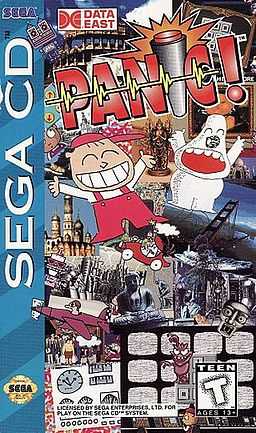Panic!
| Panic! | |
|---|---|
 North American cover art | |
| Developer(s) | Sega |
| Publisher(s) | Data East USA |
| Producer(s) | Hajime Tabe |
| Artist(s) | Renzo Kinoshita |
| Composer(s) | Kei Tani |
| Platform(s) | Mega-CD
PlayStation 2(Japan Only) |
| Release date(s) |
|
| Genre(s) | Puzzle |
| Mode(s) | Single player |
| Distribution | 1 x CD-ROM |
- For the rock band, see Panic! at the Disco.
Panic! (known as Switch! in Japan) is a video game for the Mega-CD that involves pressing numerous buttons in order to transverse a young boy, called Slap, or his dog, called Stick, through a complex labyrinth. The game was originally released in Japan, and had some risqué "gags" that were assumed to be edited out if the game ever got a North American release. However, in 1994, Data East USA decided to publish the game in North America for the Sega CD, renamed but otherwise uncut, except for two deleted stages: Level 2-B, a scene with a cigarette machine, excluded because of the tobacco reference, and Level 9-B, featuring a Japanese typewriter. The level 12-D is notorious for sending the player to the Japanese Mega-CD BIOS screen, but this scene was not changed in the American version and still showed the Japanese BIOS screen instead of the American one. The game is compatible with the Sega Mega Mouse. In 2002, the game was released for the PlayStation 2.
Gameplay
During the intro, the game explains that a virus has infected the world's computer systems. Slap and his dog Stick (who has been sucked into his TV) must carry an antidote to the central computer to fix it. To this end, Slap and Stick must traverse a grid of levels, pushing buttons to advance.
Gameplay for Panic! is very minimalistic, and likely the reason of its very low sales figures. Each level is presented as a new area with a mechanical device of varying utility and sanity, and a set of buttons to press. Each button causes an animation and/or teleports Slap to another room. Sometimes the buttons are booby-trapped and cause the destruction of a variety of monuments, including famous ones (like The Great Wall of China) and not-so-famous ones (a grass hut or a doghouse). The grid also features a few game overs on the grid, marked by flashing skulls on the map. The buttons themselves have no indication on what they do unless pressed, which makes gameplay little more than trial and error: players who enjoy the animations might frustrate over constant teleporting. It is also possible to backtrack into previous levels, and buttons once pressed are not marked, unless they were booby-trapped.
Reception
Panic! was one of only 12 games in GamePro history to earn a score of 1.0 or lower.[1] However, a few other magazines at the time had given the game positive scores for its surrealist humor. Notably Game Players magazine, describing the game as being made "for people on drugs, by people on drugs."
Richard Leadbetter, editor of Mean Machines Sega, awarded the Japanese version of the game a score of 90%.[2]
References
- ↑ "The Worst of the Worst". GamePro (200): 53. May 2005.
- ↑ Leadbetter, Richard; Rignall, Julian (1993). Mean Machines: The Essential Sega Guide. London: Virgin Books. p. 126. ISBN 0-86369-708-9.
External links
- Official page of PS2 version
- Panic! at Hardcore Gaming 101
- Panic! at GameFAQs
- Panic featured onClassicGaming
- Panic on Everything2
- Panic! at MobyGames